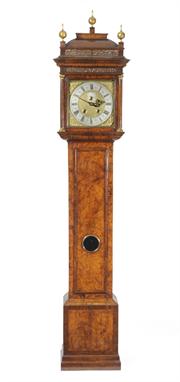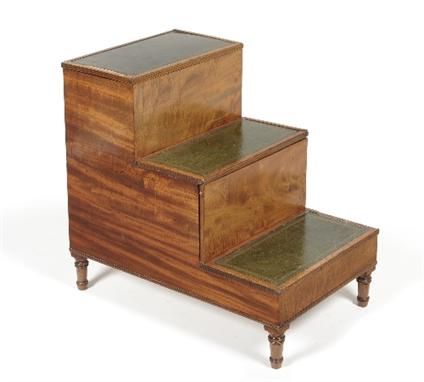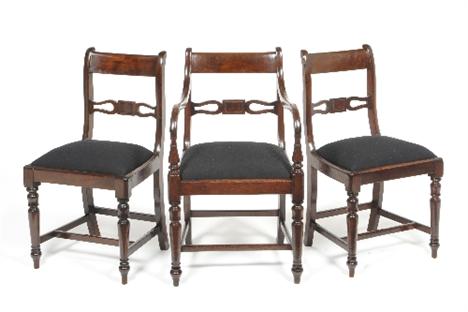A Mahogany Longcase Regulator, signed Geoe Stephenson, Warminster, circa 1830, the nicely figured case with a flat top pediment, carved cresting and canted corners, applied mounts throughout the case, glazed front door with canted corners, rectangular plinth with a raised carved and moulded frame upon a rectangular solid base, 13-inch regulator circular silvered dial with outer Arabic five minute markers, inner date ring with corresponding central date hand, dial centre with subsidiary seconds, hour dial and signed, single weight driven six pillar movement with deadbeat escapement, `Harrisons` maintaining power, glass tubed mercury pendulum (mercury has been removed from tube), 213cm high
We found 1087795 price guide item(s) matching your search
There are 1087795 lots that match your search criteria. Subscribe now to get instant access to the full price guide service.
Click here to subscribe- List
- Grid
-
1087795 item(s)/page
A Rare Brown Oak Eight Day Longcase Clock, signed Simcock, Prescot, circa 1780, the case with broken arched pediment and good figuration, turned columns, wavy shaped crossbanded trunk door flanked by inset pilasters, rectangular plinth with a raised quatre form panel and canted corners, later bracket feet, 13-inch arched brass dial with a silvered Roman and Arabic chapter ring signed, inner date ring with a corresponding central date hand, dial centre with subsidiary seconds and applied silvered floral and scrollwork with old sayings "On Times, Date:depends, Uncertain, Eternity", the arch with rolling moonphase, four pillar movement with deadbeat escapement and rack striking on a bell, 220cm high
A Mahogany Eight Day Longcase Clock, signed Major Scholfield, Manchester, circa 1780, the case with Swan neck pediment and pierced fret to the front, fluted columns, trunk with good figuration, rectangular plinth with canted corners and bracket feet, 14-inch arched brass dial with silvered Roman and Arabic chapter ring, inner date ring with central corresponding date hand, nicely engraved dial centre with bird and floral decoration, centre seconds hand, arch with rolling moonphase and signed above, four pillar movement with anchor escapement and inside countwheel striking on a bell, 244cm high
A Walnut Eight Day Longcase Clock, signed John Marsden, London, circa 1730, the case with flat top pediment, pierced frieze to the front, glazed side viewing windows, columns with brass capped capitals, feather crossbanded rectangular moulded trunk door, rectangular plinth upon a stepped base, 12-inch square brass dial with silvered Roman and Arabic chapter ring, matted dial centre with ringed winding holes, date aperture, subsidiary seconds and a oval silvered plaque signed `John Marsden, London`, five pillar movement with anchor escapement and inside countwheel striking on a bell, (case with restorations), 220cm high John Marsden is recorded working at St John`s Square, London. He was Free of the Clockmaker`s Company in 1698, and in 1731 became Master until 1741. He is known as specialising in repeating work. See Baillie (GH) Watchmakers & Clockmakers of the World, pg.210.
A Fine and Extremely Rare Burr Elm and Walnut Three Month Duration Longcase Clock, signed Morgan Lowry in Leeds, circa 1715, the attractive and nicely figured case with a later built caddied top and pierced fretwork panels, glazed movement viewing windows to the sides, gilt wooden capitals with three-quarter columns flanking the hood door, case with burr elm panels and walnut crossbanding veneers on a oak carcass, moulded edged trunk door with glazed lenticle, rectangular plinth raised upon a later built double skirting, 13-inch square brass dial with silvered Roman numeral chapter ring signed `Morgan Lowry in Leeds`, finely matted dial centre with subsidiary seconds and engraved above on a silvered plaque depicting cherubs, dial with herringbone engraving around the perimeter, finely pierced hands, the large six pillar movement with a anchor escapement and outside countwheel striking on a bell, possibly later seatboard, 260cm high Morgan Lowry (Leeds, 1682-1757) was the son of Jeremy Lowry. He is recorded as a maker of repute, and was working in London c.1700 where he picked up his skills for producing quality movements, including long duration longcase clocks. In 1703 he married Ann Boyes in Leeds and they had a daughter named Anne in 1715. His wife died in 1726 and in 1737 he married Mary Thwaites. He worked in Briggate and in Boar Lane in Leeds. He was a Sergeant at Mace for the Borough of Leeds until 1755. His clocks are extremely rare. There is a walnut long duration clock and a year going longcase clock by him in the Leeds City Museum. For more information see Britten (FJ) Old Clocks & Watches And Their Makers, pg.791; Loomes (Brian) Yorkshire Clockmakers, pg.121); and Loomes (Brian) Watchmakers & Clockmakers of the World, pg.147.
A Fine Late 17th Century Walnut Small Eight Day Longcase Clock, signed Joseph Knibb, London, circa 1690, the case with spiral twisted columns, (re-converted) back to rising hood, pierced frieze fretwork and surmounted by a later carved floral cresting, glazed side viewing windows, top of the backboard with a rising hood coiled spring and lever, rectangular trunk door with matching veneers and with moulded border, re-built plinth raised upon a moulded skirting, 10-inch square brass dial signed `Joseph Knibb, London` positioned below 6 o`clock, silvered chapter ring with Roman and Arabic numerals and typical trident half hour markers, finely engraved with floral decoration between the winged cherub spandrels, matted dial centre with date aperture below 12 o`clock position, finely pierced and sculpted blue steel hands, latches to the dial feet and to the five ringed pillars of the movement, anchor escapement, outside countwheel positioned to the movement backplate and striking on a bell, 199cm high Case backboard with a label inscribed Temple Newsam House Leeds, Exhibition of English Clocks 1949, No.21. This clock is recorded in the catalogue of Exhibition of English Clock 1600-1850, September 3rd - October 9th 1949, No.21. The catalogue states A William and Mary longcase clock by Joseph Knibb London, circa 1690, in a oak case with walnut veneer, formerly in the Fitzwilliam Museum, Cambridge and Lent by Harold Wildsmith Baxter, Esq. Harold Wildsmith Baxter was one of the great post war collectors of Early English Clocks. Sold together with a photocopy of the Exhibition of English Clocks catalogue entry No.21. Joseph Knibb, the most famous and inventive member of the celebrated Knibb clockmaking family, was born in 1640. In 1655 he was apprenticed to his cousin Samuel and after serving seven years he worked first at Oxford and then moved to London in 1670, where he was made Free of the Clockmaker`s Company. Records show he supplied a turret clock for Windsor Castle in 1677 and payments were made to him in 1682 by King Charles II. Towards the end of the 17th century Joseph Knibb moved to Hanslop in Buckinghamshire. By the early 18th century Knibb had virtually retired and he died in December 1711.
A Fine and Rare 18th Century Walnut Stick Barometer, signed Jno Hallifax, Barnsley, Invt & Fecit, circa 1730, the finely figured case in the form of a longcase clock, caddied pediment with turned brass finials, inlaid stringing and turned side columns to the pediment, trunk with boxwood stringing and a central recording chapter ring with two hands, rectangular plinth with stringing and upon a waisted base, 6-inch arched brass dial with a silvered chapter ring and elaborately engraved with scrollwork to the dial centre, the arch with a circular silvered disc signed `Jno Hallifax, Barnsley, Invt & Fecit`, 130cm high John Hallifax (b.1694-d1750), the son of a vicar, he started in business in 1711. He became a notable clock and barometer maker and only a small number of his barometers survive today. His designs are distinctive and based on longcase clocks. See Banfield (Edwin) Barometer Makers and Retailers, pg.102
A 19th Century Yewwood and Elm Windsor Chair, the low double bow back with pierced splat and ring turned arm supports, the moulded seat raised on turned spindle legs joined by a crinoline stretcher, 63cm by 45cm by 95cm; and A 19th Century Yew and Elm Single Chair, the slightly curved top rail above seven moulded uprights, the shaped elm seat raised on turned spindle legs joined by an H stretcher, 43cm by 40cm by 83cm (2)
A Joined Oak North Wales Cwpwrdd Tridarn, the canopy with a bold cornice above baluster ring turned supports, the cupboard with inverted finials above two fielded panel doors around a central panel dated 1668 initialled MI, the lower section with three frieze drawers above two fielded panel doors and raised on bracket feet, 137cm by 55cm by 203cm
A Late Regency Mahogany Pedestal Sideboard, 2nd quarter 19th century, the scrolling acanthus leaf carved superstructure and shelf above a bowfront top, the long frieze drawer flanked by two small drawers with two cupboards below fitted with shelves, raised on ring turned toupie feet,183cm by 58cm by 140cm
A Regency Flame Mahogany Sofa Table, 2nd quarter 19th century, with two rounded drop leaves above two real and two sham opposing drawers, raised on ring turned baluster supports with block bases united by a twin turned and spiral decorated understretcher, with sabre legs terminating with leaf cast toes and castors, 92cm by 72cm by 75cm
A George IV Mahogany Washstand, 2nd quarter 19th century, with two hinged sections opening to reveal six lidded compartments and an easel mirror sliding on a ratchet, the shaped apron flanked by two small frieze drawers, raised on ring turned spiral twisted tapering legs with brass toes and castors, 71cm by 51cm by 87cm
A George IV Mahogany Breakfront Sideboard, 2nd quarter 19th century, the top formerly fitted with a brass gallery, the single frieze drawer above an arched apron, flanked by a deep drawer and cupboard door with brass ring drop handles, all between reeded and tapering supports, 214cm by 71cm by 94cm
A Victorian Mahogany Bookcase, 3rd quarter 19th century, the ogee cornice above a plain frieze and twin glazed astragal doors enclosing adjustable shelves, all between leaf carved scrolling capitals and moulded columns, the base with two recessed doors and raised on ring turned feet, 131cm by 56cm by 230cm
A Pair of Chinese Gilt Metal Mounted Porcelain Baluster Vases, 19th century, of archaic form with flared rims applied with bronzed lion`s mask and ring handles and bands of cloud scroll and Greek key on a crackle ground, the bases with ovolo and foliate decoration, 46cm high
A Chinese Chalcedony Snuff Bottle, Qing Dynasty (1800-1850), of flattened circular form, 5.5cm high; Three Chinese Rock Crystal Snuff Bottles, circa 1800-1900, one of spade form with taotie mask and ring side handles, one as a textured fruit, the other of panelled circular form (4)
A 14 Carat White Gold Moonstone and Diamond Cluster Ring, the cabochon moonstone within a border of round brilliant cut diamonds, a tapered baguette cut diamond at each corner, in claw settings to a plain polished shank, total diamond weight 1.00 carat approximately, finger size M
An 18 Carat Gold Sapphire and Diamond Three Stone Ring, an oval cut sapphire flanked by an old European cut diamond on each side, with smaller rose cut diamond accents around, in claw settings on a later carved mount and plain polished shank, total diamond weight 3.00 carat approximately, finger size P1/2
An Art Deco Diamond and Pearl Ring, two button pearls centrally, with a border of four rose cut diamonds to the top and to the bottom, and an old cut diamond to each shoulder, in white claw settings to a plain polished shank, total diamond weight 0.65 carat approximately, finger size N1/2
A Diamond Solitaire Ring, by Tiffany & Co., a `Lucida` cut diamond in a white four claw setting to a plain polished shank, finger size M The ring is accompanied by a report from Tiffany & Co., number 18541165/E12160061, stating the diamond to be 0.32 carat, colour H, clarity VVS2.
A Sapphire and Diamond Cluster Ring, the central mixed cut sapphire in a yellow millegrain setting within a border of ten old cut diamonds in white millegrain settings, to a yellow knife edge shoulder shank, total estimated diamond weight 0.90 carat approximately, finger size J1/2
A Sapphire and Diamond Ring, a pair of old cut diamonds flanked by two round cut sapphires, two further old cut diamonds at each terminal, in yellow and white claw settings on a yellow plain polished shank, total estimated diamond weight 0.50 carat approximately, finger size M
-
1087795 item(s)/page




























































